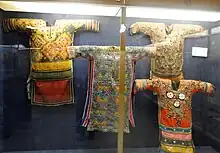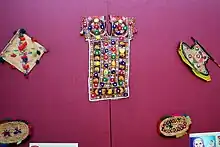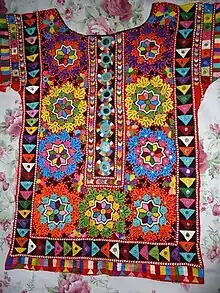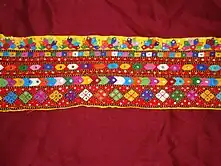
Sindhi embroidery (Sindhi: سنڌي ٿرت) comes from the arid province of Sindh in southern Pakistan, which has always been famed for its embroidery.[1]
Background
The girls of the various farming, herding and merchant castes of Sindh have a dowry tradition in which the girl to be married will create with the help of her female relatives an embroidered trousseau consisting of costumes for herself, for the bridegroom, hangings for the home, quilts, and even trappings for the domestic animals: camels, horses and oxen. All these will be presented at the wedding ceremony to show her prowess with a needle and to prove that she is ready to take up her duties as wife, mother and homemaker. Pieces are decorated in a bewildering variety of techniques. Applying tiny mirrors attached with buttonhole and other stitch is the technique most characteristic of Sindhi work, but couching, appliqué and metal thread work are also very popular. Each caste has its own designs and motifs and favored color schemes particular array to such a degree that embroidery becomes a mark identification. A certain style of needlework becomes a badge of cultural identity. What is worn indicates caste, status and often the very village to which one belongs. It is seen as the duty of the mother to pass on the embroidery styles of a particular community to her daughter unchanged through the generations to maintain this particular identity.
Fine embroidered dowry textiles are still part of life all over Sindh through the regions in which they are worked in profusion are the deserts of Sindh, such as Thar Parkar and Nagar Parkar. Other parts of Sind such as Thano Bula Khan area have very strong embroidery traditions linked to ostentatious marriage display, a custom of certain merchant castes. Sindhi embroidery is profuse, vibrant and still very much alive.[2][3]

History
Sindhi women excelled in needlework. The thin bronze needles (resembling those used for embroidery) from the excavations of Mohenjo-Daro are witness to this craft and this support the evidence of embroidery in that era. Sindhi women make fantastic patterns of rich, brilliant colours gleaming with mirrors, shells and beads. Zardosi, a special type of embroidery with a silver or golden thread, is also very famous throughout Sindh.[4][5]
Mirrorwork
Mirrorwork (Shishe jo kam/Kawan jo kam) in Sindhi. The tradition of mirrorwork embroidery is one of the major features of regional embroideries of Sindh. Sindh along with its neighbour regions are considered to be the hub of mirrorwork.
Sindh provides diverse examples of mirror work. Almost every community practices its own unique style of embroidery. Thus the styles of mirror embroidery also vary from one community to another. The style, colour, shape and even some times stitchery of mirror embroidery are also different from one region to another and from one community to another. Much of these aspects have evolved through modifications and enhancements from time to time. Foreign invasions and migrations of people from other regions have further enriched the work by intermixing of different cultures in this region.[6]
Researchers from different parts of the world have worked on the indigenous embroideries of Sindh. Several authors described the mirror embroideries of different regions of Sindh, which includes: Ghotki, Shikarpur, Jacobabad, Khairpur, Sukkur, Mirpur Mathelo, Thano Bula Khan, Thatta, Badin, Hyderabad, Hala, Nawabshah, Mirpurkhas, Sanghar, Kashmore and multiple regions of Thaparkar particularly Umarkot, Chachro, Diplo, Nagarparkar and Mithi.[6]


In older times a mirror was assumed to frighten the evil spirits away, by terrifying them, by their own reflections. Also in ancient civilizations when sun was worshiped. The people see the gigantic sun as a sign of divine, hope or deity in itself.[6]
Askari and Crill surveyed different regions of Sindh which produce mirror embroidery and also have catalogued the communities which produce mirror embroidery such as Mahar community near Shikarpur and Ghotki, Jat community in Badin, farming groups of Hyderabad, Hala and Nawabshah Lohana, Pallari and Burfat groups from Thano Bula Khan and a number of communities of Tharparkar region. Yacopino identified the Umarkot, Hyderabad, Sanghar and Kashmore, as some of the most important centres of mirror embroidery in Sindh.[6]
Earlier, the mirror embroidery was mainly used for making Gaj (A solid embroidery over the woman's shirt it usually covers the area, starting from neck up to the stomach. It incorporates variety of stitches and colors. Sometimes, it is made on separate piece of cloth and then attached to the garment). Earlier, the mirror embroidery was limited to the adornment of women's attire But some of the men's products like Sindhi Topi, Agath (drawstring used in traditional pants) and Ganji are also adorned with mirror embroidery.[6]
Types of Sindhi Embroideries
There are so many Sindhi Stitches, some of them are mentioned below:[7][8]
- Hurmuch/Hurmucho
- Pakko
- Kacho
- Mukko
- Marori
- Kundhi
- Aar
- Kharek
- Soof
- Pani work
- Band
- Reso
- Bakhiyo
- Gano
- Maahi
- Kashmiro
- Aaoka
- Bijja
- Seera
- kunh
- Zanjeeri tako
See also
References
- ↑ "Sindhi Hand Embroidery". I. 2016-12-05. Archived from the original on 2023-05-27. Retrieved 2023-05-27.
- ↑ Dhamija, Jasleen (2004). Asian Embroidery. Abhinav Publications. ISBN 978-81-7017-450-9. Archived from the original on 2023-10-05. Retrieved 2023-10-05.
- ↑ Naik, Shailaja D. (1996). Traditional Embroideries of India. APH Publishing. ISBN 978-81-7024-731-9. Archived from the original on 2023-10-05. Retrieved 2023-10-05.
- ↑ Reejhsinghani, Aroona (2004). Essential Sindhi Cookbook. Penguin Books India. ISBN 978-0-14-303201-4. Archived from the original on 2023-10-05. Retrieved 2023-10-05.
- ↑ Lushwa (2023-01-29). "Sindhi Embroidery: The Art of Hand-Stitched Beauty". Archived from the original on 2023-05-27. Retrieved 2023-05-27.
- 1 2 3 4 5 Leghari, Saba Qayoom (29 June 2019). "Evolution of Mirror Embroidery in Two Villages of Sanghar Sindh". International Journal of Arts, Culture, Design & Language Works. 6 (6): 17–23. Archived from the original on 5 October 2023. Retrieved 27 May 2023.
 This article incorporates text from this source, which is available under the CC BY 4.0 license.
This article incorporates text from this source, which is available under the CC BY 4.0 license. - ↑ Nana, Shireen; Mirza, Shireen Nana Nee (1990). Sindhi Embroideries and Blocks. Department of Culture and Tourism, Government of Sindh. ISBN 978-969-8100-12-4. Archived from the original on 2023-10-05. Retrieved 2023-10-05.
- ↑ "Embroidery - Sindhi Muslim". Mano Etna. Archived from the original on 2023-05-27. Retrieved 2023-05-27.